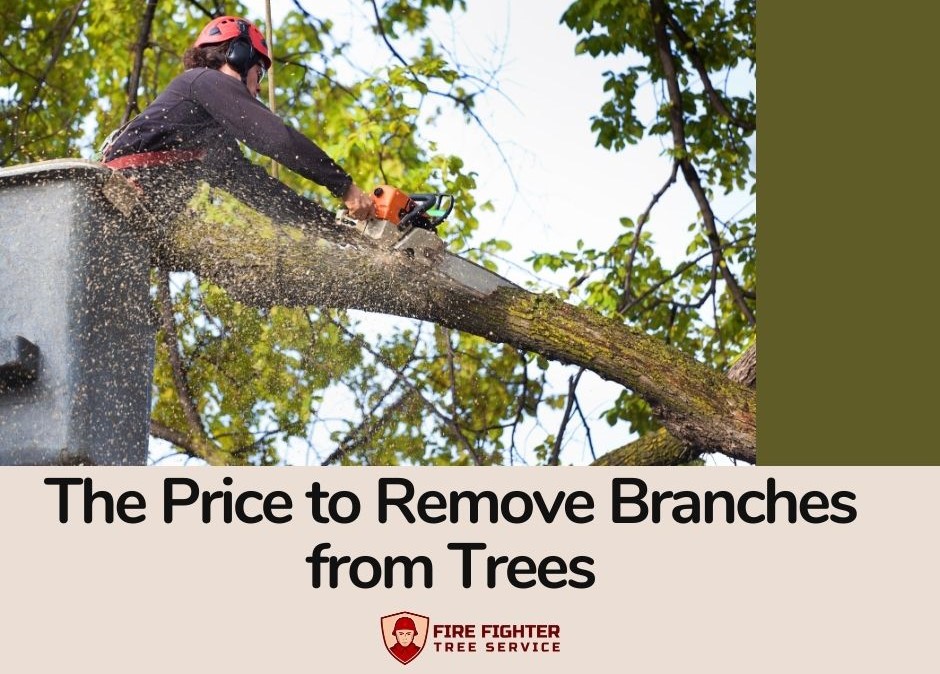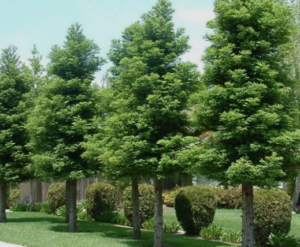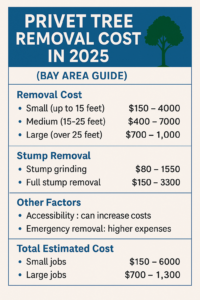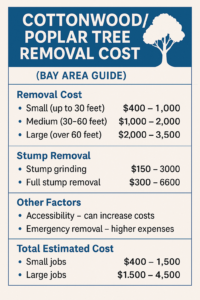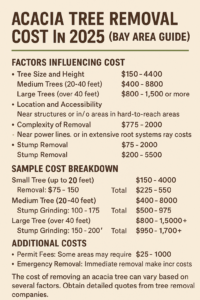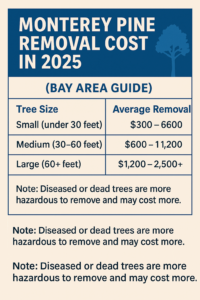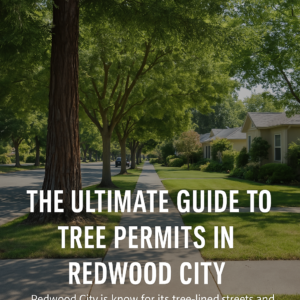Tree maintenance is unavoidable in homeownership, especially in the Bay Area, where the natural landscape is a significant part of the region’s charm. Among the various tree care services, removing branches is a common necessity. It can be for aesthetic reasons, safety, or tree health.
For this reason, one might ask, how much does it cost to remove branches from trees in the Bay Area? In this article, we will explore:
- Factors Influencing the Cost of Branch Removal
- Average Pricing in the Bay Area
- Detailed Pricing Breakdown
- Additional Costs to Consider
- Benefits of Professional Branch Removal
Factors Influencing the Cost of Branch Removal
The cost of removing branches from trees can vary widely based on several factors:

1. Tree Size and Type
Height and Width: Larger trees require more work, equipment, and safety precautions, increasing costs. For example, removing branches from a towering Redwood tree is more labor-intensive than removing branches from a smaller, ornamental Japanese Maple.
Species: Some tree species have tougher wood or more extensive branches, influencing the difficulty and time required for removal. Eucalyptus trees, common in the Bay Area, often have dense wood and extensive branch systems, making branch removal more challenging and costly.
2. Branch Size and Number
Thickness and Length: Larger, thicker branches are harder to remove and dispose of, increasing costs. A thick branch from an oak tree will take more time and effort to cut and remove compared to thinner branches from a fruit tree.
Quantity: The more branches that need removal, the higher the overall cost. Removing numerous small branches can be as labor-intensive as removing a few large ones.
3. Location and Accessibility
Proximity to Structures: Branches near homes, power lines, or other structures require more careful handling and specialized equipment, leading to higher prices. For instance, branches hanging over a roof or near utility lines pose additional risks and require meticulous work.
Accessibility: If the tree is in a hard-to-reach area, additional equipment like cranes or climbing gear might be necessary, further increasing costs. Trees located on steep hillsides or in tightly packed urban settings can be more challenging to access.
4. Health and Condition of the Tree
Dead or Diseased Trees: These can be more hazardous to work on, requiring extra precautions and potentially more labor. Dead branches are unpredictable and may break unexpectedly, necessitating additional safety measures.
Healthy Trees: While generally easier to work on, large healthy branches can still be challenging and costly to remove. Proper techniques are required to avoid damaging the tree during branch removal.
5. Season and Demand
Seasonality: Prices can fluctuate based on the time of year, with some seasons experiencing higher demand for tree services. Spring and summer, when trees are actively growing, often see increased demand and higher prices.
Emergency Services: Storm damage or urgent removals often attract a premium price tag. After a storm, there may be an influx of emergency calls, driving up costs due to increased demand.
Average Pricing in the Bay Area
In the Bay Area, the cost to remove tree branches can range from as low as $150 to upwards of $1,000 or more, depending on the factors outlined above. Here’s a more detailed breakdown:
- Small Trees (up to 30 feet): $150 – $400
- Medium Trees (30 to 60 feet): $400 – $800
- Large Trees (60 to 100 feet): $800 – $1,500
- Extra-Large Trees (over 100 feet): $1,500 and up

These prices include labor, equipment, and disposal but may vary depending on specific circumstances and service providers.
Detailed Pricing Breakdown
For a clearer picture, let’s look at the cost components in more detail:
1. Labor Costs
Labor is typically the most significant part of the cost. Skilled arborists may charge between $75 and $150 per hour. This rate reflects their expertise, the physical demands of the job, and the safety risks involved.
2. Equipment Costs
Depending on the complexity of the job, various equipment might be needed, from chainsaws and pruning shears to larger machinery like cherry pickers or cranes. Rental or usage fees for such equipment can add significantly to the total cost.
3. Disposal Fees
After branches are removed, they need to be disposed of. Disposal fees can vary depending on the amount of debris and local regulations. Some companies include this in their overall pricing, while others charge extra.
4. Insurance and Permits
Professional tree services carry insurance to protect against potential damages or accidents. In some cases, permits might be required for tree work, especially in areas with strict environmental regulations. These costs can also be factored into the final price.
Additional Costs to Consider

Permits and Regulations
Depending on your municipality, you may need permits for significant tree work, particularly if the tree is protected or if the work impacts public property. For example, some areas in the Bay Area have strict regulations regarding the removal of branches from heritage trees.
Cleanup and Disposal
Some companies include branch chipping and debris removal in their pricing, while others may charge extra for these services. Be sure to clarify this when getting quotes.
Travel Fees
Some companies may charge additional travel fees for remote locations or particularly inaccessible properties. If your property is in a less accessible area, these fees can add to the overall cost.
Benefits of Professional Branch Removal
Hiring a professional for branch removal offers several benefits:
Safety
Removing branches, especially large or hazardous ones, can be dangerous. Professionals have the training and equipment to do the job safely. This reduces the risk of injury to yourself and damage to your property.
Tree Health

Proper pruning and branch removal can improve tree health by removing diseased or damaged limbs and promoting better air circulation and sunlight penetration. Incorrectly removing branches can harm the tree, so professional expertise is valuable.
Aesthetic Appeal
Skilled arborists can enhance the appearance of your trees, contributing to your property’s overall curb appeal. A well-maintained tree can significantly improve the look of your yard.
Prevention of Property Damage
Removing potentially hazardous branches can prevent damage to your home, vehicles, and other structures, saving you money in the long run. Proactively addressing risky branches helps avoid costly repairs.
